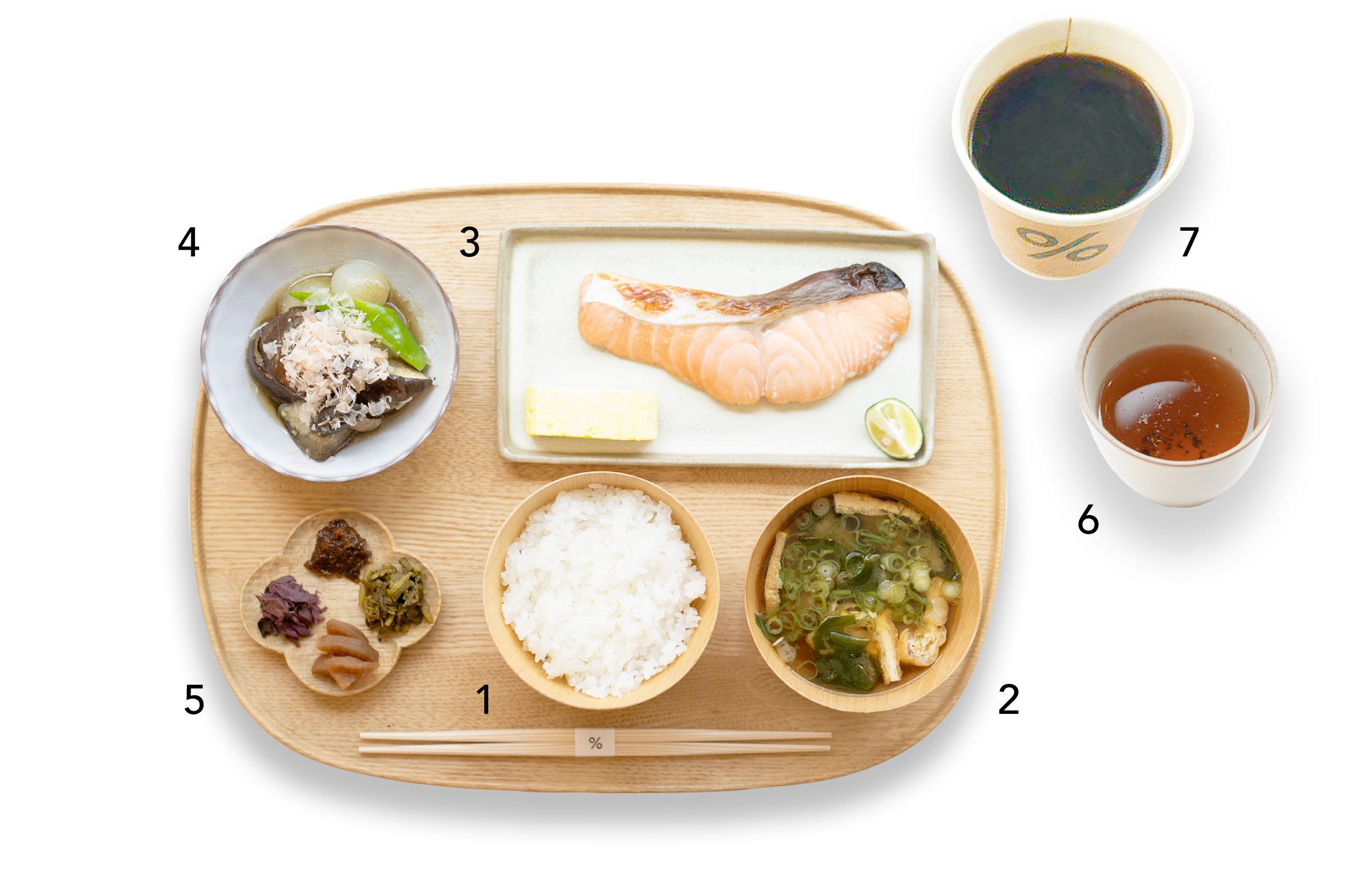
1. Rice : Blend Rice
・ A blend of rice cultivated naturally using no pesticides, no fertilizers, or organic fertilizers in the best combination.
・ The rice is polished on the morning of the day it is served and cooked in an earthenware pot timed to match the customer’s arrival.
2. Miso Soup : Miso soup with green onions, wakame seaweed, and fried tofu.
・ After the customer arrives, the miso is dissolved in the broth and served immediately in a bowl.
・ The broth is made with the finest 3-year-aged Rishiri kelp from Hokkaido, dried bonito from Kagoshima, mackerel flakes, and dried sardine flakes (occasionally using high-quality natural fish bones if available).
・ Miso includes 3-year-aged brown rice miso, rice miso, and white miso from Nagano Prefecture.
・ Kujo onions from Kyoto (organically grown).
・ Wakame seaweed from Miyagi Prefecture.
・ Fried tofu from Kyoto.
3. Main Dish : Homemade Dried Tokishirazu Salmon.
・ Tokishirazu salmon is processed and landed at the Rausu (Hokkaido fishing port). This salmon is estimated to be migrated upstream into rivers in Russia, and is caught when it passes through Japan’s territorial river during its migration. Because it is caught earlier than autumn salmon, which is classified as white salmon,therefore it is called “time less salmon,” in other words “toki-shirazu.” Because of the meat covered in fat, the meat is soft, elegant, and has a rich flavors . The fillets are lightly sprinkled with salt, dried overnight, and then grilled over Kishu Bincho Charcoal.
・ Served with Sudachi citrus.
: Dashi-maki Tamago (Japanese-style rolled omelet).
・ Free-range eggs from Sumoto, Awaji Island.
・ Broth made with the finest 3-year-aged Rishiri kelp from Hokkaido, mackerel flakes, and dried sardine flakes.
4. Side Dish : Simmered miniature onions (pekorosu), Kamo eggplant, Manganji peppers, and Daikoku hon-shimeji mushrooms, topped with bonito flakes.
・ Bonito flakes shaved after the customer arrives (Katsuo, high-quality whole dried bonito).
・ Miniature onions (pekorosu) cultivated naturally from Sumoto, Awaji Island.
・ Kamo eggplant.
・ Manganji peppers.
・ Daikoku hon-shimeji mushrooms.
5. Pickles
・ Shibazuke pickles from Ohara, Kyoto (naturally grown).
・ Pickled seasonal vegetables in rice bran.
・ Boiled and pickled daikon radish and ginger from Kyoto.
・ Miso made from fukinoto (butterbur sprouts) and sansho (Japanese pepper) chirimenjako (dried baby sardines) mix.
6. Japanese Tea
・ Hojicha Chai: Sprinkled with red sansho pepper from Kyoto for a spicy aroma.
7. % Coffee
・ Choose your favorite espresso drink after the meal. Takeout is also available.
1. ご飯:ブレンド米
・ブレンド米・無農薬、無肥料又は有機肥料で栽培した自然栽培のお米をベストな配合でブレンドしています。
・提供する日の朝に精米をしたお米を、お客様のご来店時間に合わせて土鍋で炊き上げています。
2. お味噌汁:青葱とワカメとお揚げの味噌汁
・お客様がご来店してから出汁に味噌を溶いて、椀に汁をそそぎ、直ぐに提供します。
・北海道産の最高級の蔵囲い3年利尻昆布と鹿児島産の鮪枯節と鯖節と宗田節で引いたお出し。(良質な天然魚の荒骨があれば出汁材料として使用する事もあります。)
・長野県産の3年熟成の玄米味噌と米味噌と白味噌。
・京都産の青葱。(有機栽培)
・宮城産のワカメ。
・京都産お揚げ。
5. お漬物
・京都大原産の志ば漬。(自然栽培)
・季節の野菜の糠漬け。
・京都産の大根と生姜の煮切り漬け。
・ふきのとう味噌と山椒じゃこの和え物。
6. 日本茶
・ほうじ茶チャイ:京都産の赤山椒を最後に振ってスパイシーな香りを出しています。
7. % コーヒー
・食後にお好きなエスプレッソドリンクをお選びください。テイクアウトも可能です。

3. 主菜:天然時鮭(時知らず)の自家製干物
・羅臼で揚がった時鮭。ロシアの河川に遡上すると推定される鮭で、回遊中に日本の領海内を通るときに捕獲されます上は同じ白鮭の秋鮭より漁獲されるのが早いために、時をまちがえた鮭、すなわち『時知らず』と呼ばれていす。脂が全体にのっているため、身がやわらかく上品で濃厚な旨味が特徴です。切り身に薄く塩をふり、一晩乾燥させてから、紀州備長炭の炭火で焼いています。
・新物のすだちを添えて。
*不漁の時は別の産地のアジを使用する場合もございます。
:出汁巻き卵
・淡路島洲本の平飼い卵。
・北海道産の最高級の蔵囲い3年利尻昆布と鯖節、宗田節でとったお出汁。
4. 副菜:極小サイズの玉ねぎ(ペコロス)と賀茂茄子と伏見唐辛子とブナシメジの煮物、鰹節をトッピング
・お客様がご来店してから削る鰹節。(南方一本本枯節オモ)
・淡路島洲本の自然栽培の極小サイズの玉ねぎ (ペコロス)
・賀茂茄子。
・伏見甘長唐辛子。
・熊本産ブナシメジ。(農薬不使用)